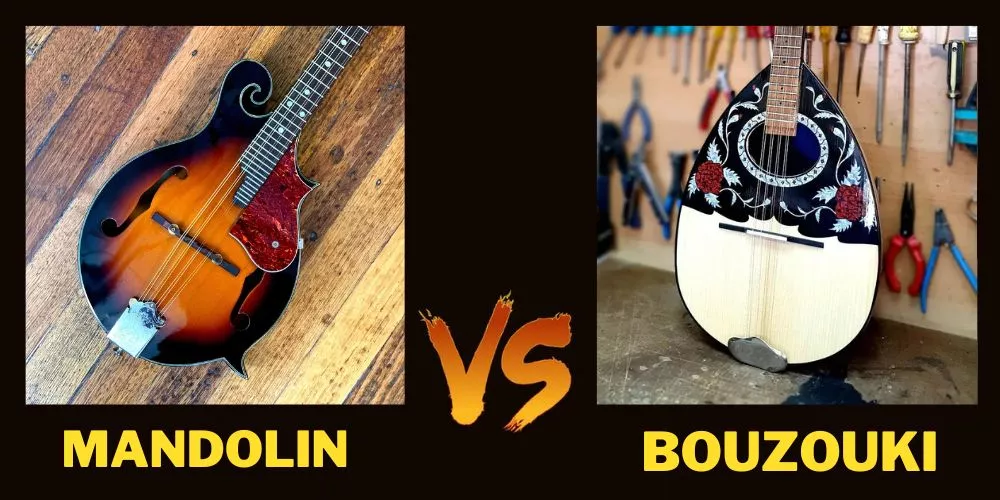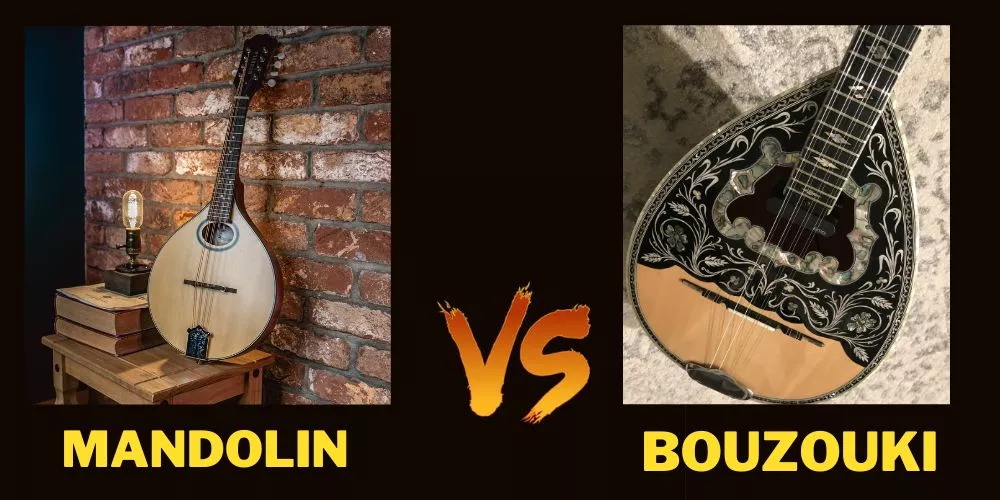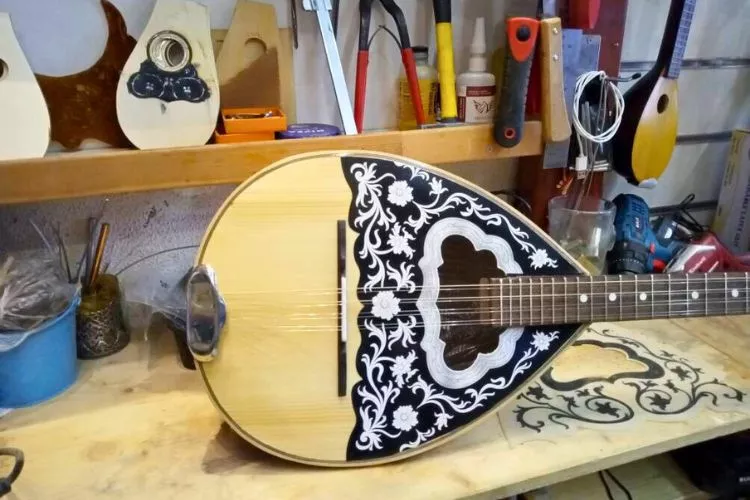Mandolin and the bouzouki are two distinctive string instruments that hail from the romantic landscapes of Italy and Greece, respectively. But, it’s important to address the mandolin vs bouzouki debate to help people choose one among them.
Although both belong to the lute family, the key difference lies in their cultural use and core sound characteristics.

The mandolin is celebrated for its bright, ringing tone, often played with a fast tremolo in genres like bluegrass, folk, and classical music.
On the other hand, the bouzouki’s uniquely deep and resonant tone forms the heartbeat of traditional Greek music.
This comprehensive guide compares the two, delving into their history, construction, and playing techniques.
Whether you’re a curious music lover, an aspiring musician, or a seasoned player, join us in exploring these musically enriching instruments.
Contents
🎶Mandolin vs. bouzouki: What is the difference between a bouzouki and a mandolin?
The mandolin, born in Italy, is a descendant of the lute family and has undergone significant evolution, gaining a prominent place in classical music.
It further diversified into several families, including Neapolitan, Lombard, Milanese, Florentine, and Cremonese, each with unique physical traits and tonal character.
On the other hand, the bouzouki, rooted in Greece and influenced by the Turkish saz, showcases the distinct flavors of traditional Greek music.
Its development took a notable leap in the 20th century, shaping the modern bouzouki, now described as the backbone of Greek contemporary music.
Despite both mandolin and bouzouki descending from the lute family, their cultural context and musical utility have sculpted them into two unique instruments with different histories and roles.

Construction and Design
The mandolin comes in two main shapes: the rounded, teardrop A-style and the scrolled, ornate F-style, often made from spruce, maple, or mahogany woods.
It employs eight strings arranged in courses, producing a bright, resonant tone through its oval or f-shaped sound holes, variable with design iteration.
On the other hand, the bouzouki sports a longer, rounded shape reminiscent of a lute with varying bowl depths.
Crafted typically from spruce or maple, the instrument can have either six or eight strings arranged in three or four courses according to modern (trichordo) or traditional (tetrachordo) designs.
These strings resonate through round or f-shaped sound holes, giving the bouzouki its unique timbre. While both instruments share aesthetic semblance, their design variations underpin the distinct tonal palette and cultural significance each brings to the music world.
Playing Techniques
Mandolin utilizes various plectrum techniques, including tremolo, alternate picking, cross-picking, and downstroke, allowing it to shine in solo and accompaniment roles.
Adding to its versatility, fingerstyle techniques such as arpeggiation, chordal strumming, and accompaniment further expand the instrument’s expressiveness. The mandolin is fundamental in bluegrass, classical, Celtic, and Italian folk styles.
On the other hand, Bouzouki‘s charm lives in its plectrum techniques, like the fast tremolo and rhythmic strumming.
Fingerstyle techniques, while not as prevalent as in mandolin playing, do exist and encompass arpeggiation and fingerpicking. This instrument’s prowess resounds prominently in Rebetiko, Laiko, and contemporary Greek music styles.
By comparing these techniques, it’s clear how each instrument’s cultural heritage influences its playing methods, enriching specific musical styles.
Tone and Sound Quality
The mandolin is renowned for producing a bright, loud, ringing tone that can stand out in a musical arrangement. Its sound is largely influenced by the choice of wood and the instrument’s design: a smaller body and paired strings create its signature sound.
In comparison, the bouzouki boasts a deep, resonant, and rich tone that bears the heart and soul of Greek music.
The choice of wood has a significant role in shaping this distinct sound. Moreover, its unique string setup, with doubled or tripled courses, adds to the characteristic warm, full-bodied resonance.
Whether one prefers the crisp clarity of a mandolin or the resonant depth of a bouzouki largely depends on personal taste and music genre. Yet, the diversity in their tones proves how construction choice significantly influences an instrument’s sound profile.
Playing Difficulty and Learning Curve
A series of points emerge in assessing the Playing Difficulty and Learning Curve of two string instruments, namely the Mandolin and the Bouzouki.
Regarding the Mandolin, players may have difficulty fretting due to the instrument’s compact scale length. This results in the strings being closer together. Typically, the mandolin is strung in what is known as ‘courses’, or pairs of strings.
This layout requires somewhat greater finger strength to effectively press down. A unique challenge of the mandolin is mastering the right-hand tremolo technique. The speed and precision demanded by this technique can prove challenging to beginners.
When considering the learning curve of the Mandolin, prospects are good. The instrument is prevalent in many genres of music, from classical to folk and bluegrass. This popularity results in a wealth of learning resources, easing the journey for aspirant players.
Transitioning to the Bouzouki, this instrument presents its own set of challenges. It features a larger fretboard, which can make chord transitions – especially larger stretches – more complicated, particularly for individuals with smaller hands.
Players must also develop proficiency in specific plectrum techniques to effectively bring out the unique sound of the bouzouki.
Concerning the learning curve of the Bouzouki, one should consider the instrument’s cultural heritage. It is an integral part of Greek music, meaning that the availability and diversity of learning resources might not be as ample.
Nonetheless, niche communities and guides can provide invaluable support for those interested in this musical tradition.
Both the Mandolin and the Bouzouki offer rewarding musical experiences. When choosing between them, it’s important to consider playing not only the difficulty and learning curve but also personal musical preferences and objectives.
Instrument Maintenance
In comparing the Instrument Maintenance of the Mandolin and the Bouzouki, several points of consideration and procedures arise, often specific to each instrument.
Addressing the Mandolin first, regular string changes are imperative. A unique aspect is how different strings can affect the instrument’s sound, necessitating careful choice and experimentation.
Maintenance also requires diligent cleaning habits to preserve the instrument’s condition and longevity, including cleaning strings and the fretboard after each play session.
Critical to maintaining a mandolin is considering the impact of humidity and temperature; closely controlling these environmental factors can safeguard the instrument’s condition during storage and care.
Contrarily, the Bouzouki imposes different maintenance routines and considerations. Key among them is string maintenance and changes. As with the mandolin, the frequency of play, type of strings, and personal preference will influence when string changes are necessary.
Cleaning and caring for a bouzouki share many similarities with the mandolin, including regular cleaning, particularly after use, to prevent sweat and dirt buildup, which can affect the instrument’s lifespan.
Unique to the bouzouki, and unlike the mandolin, is the guidance for adjusting the instrument’s truss rod and bridge for action and intonation.
These adjustments, which should be done carefully and preferably with expert guidance if a player is inexperienced, are crucial in maintaining your instrument’s tone and playability.
In summary, both the Mandolin and the Bouzouki require regular maintenance, though certain elements of their care diverge based on each instrument’s design and unique characteristics.
Accessory Requirements
In comparing the Accessory Requirements of the Mandolin and the Bouzouki, it is crucial to understand the unique demands of each instrument to ensure the best playing experience and optimal protection.
For the Mandolin, several accessories emerge as necessities. Picks, cases, straps, and extra strings are the most crucial. Using the appropriate pick enhances the player’s ability to achieve their desired sound, while a reliable case protects the instrument during travel or storage.
Straps are valuable for player comfort during the performance, and extra strings ensure readiness for any situation.
Additionally, the importance of a good-quality mandolin stand cannot be overstated. It not only offers protection but allows for easy access, promoting regular practice and maintenance habits.
Similar accessory requirements come into play when considering the Bouzouki, with some variations.
Emphasis should be placed on the value of suitable picks, capos, tuners, and cases specifically designed for the bouzouki. Since this instrument has a distinct shape and size, a specialized case is vital for proper fit and protection.
Picks are integral to the bouzouki’s unique sound, while capos and tuners facilitate accurate pitch control.
Bouzouki-specific accessories, such as truss rod wrenches for adjustments, play a key role in maintaining instrument stability, tone, and playability. These tools should only be used after proper guidance to avoid potential damage.
In conclusion, the Mandolin and the Bouzouki have distinct accessory requirements catering to their unique designs and demands.
As a player, understanding and investing in appropriate accessories will enhance the playing experience and protect the instrument in the long run.
Repertoires and Genres
In comparing the Repertoires and Genres associated with the Mandolin and the Bouzouki, it becomes clear that each instrument enjoys a distinct musical presence across different styles.
Mandolin repertoire and genres cover a broad range of musical styles, including:
- Classical music: The mandolin has a rich history in classical music, featuring compositions by famous composers such as Vivaldi, Beethoven, and Raffaele Calace.
- Traditional/folk music: The mandolin is a popular choice in various traditional and folk music styles, including Italian, Irish, and American folk, where it often plays a crucial role.
- Popular music genres: The mandolin’s versatility extends to popular music genres such as bluegrass, country, jazz, and rock, showcasing the instrument’s adaptability and expressive potential beyond traditional settings.
In contrast, the Bouzouki is deeply rooted in Greek musical tradition, with a repertoire centered around specific styles:
- Traditional Rebetiko music: Originating in the early 20th century, it strongly connects to the bouzouki, which plays a prominent role in its melancholic and introspective expression.
- Modern Laiko music: As a popular modern Greek music style, Laiko commonly incorporates the bouzouki, highlighting the instrument’s continued significance in contemporary Greek culture and music.
- World music genres: While most familiar in Greek music, the bouzouki has found its way into other genres, such as Irish traditional music and fusion genres, demonstrating the instrument’s capacity for transcending cultural boundaries.
Ultimately, the Mandolin and the Bouzouki showcase their unique character and expressivity across various repertoires and genres.
This comparison highlights the potential for musicians to find joy and satisfaction in playing either instrument, depending on their musical preferences and ambitions.
🎶Why choose a mandolin?
You might choose a Mandolin for many compelling reasons. One of the main reasons is that it’s an accessible instrument for beginners.
The mandolin’s small size and relatively simple, basic chord structures make it an inviting entry point into making music.

It’s also regarded as relatively easy to learn since it has fewer strings compared to many other stringed instruments. This characteristic makes reading tablature considerably easier.
🎶Why choose a bouzouki?
On the other hand, the Bouzouki could be your instrument of choice if you are interested in specific types of music. Although its primary presence is in Greek music, the Bouzouki has increasingly found its place in other World music genres.

Its distinctive, rich tones and rhythms drive the soulful music of Rebetiko and modern Laiko, proving an authentic experience.
Moreover, the Bouzouki allows for unique explorations in Irish traditional music and various fusion genres.
Also, dedicating to this instrument could signify a commitment to understand and immerse oneself in the cultural nuances of the music it primarily represents.
🎶Frequently Asked Questions (FAQs)
Answer: Yes, you technically can, but it may not produce the optimal sound for a bouzouki. It’s important to remember that each instrument is designed to produce its distinctive sound based on its specific tuning.
Answer: The mandola, mandocello, and octave mandolin are string instruments similar to the bouzouki. Also, the lute, the saz, and the Irish bouzouki have similarities in shape, sound, and playing technique.
Answer: A small bouzouki is often referred to as a tzouras. It has a smaller body and usually fewer strings than a traditional bouzouki.
Answer: The mandola is the closest instrument to a mandolin, with a similar shape, size, and string configuration, just slightly larger and tuned a fifth lower.
Conclusion:
Both the mandolin and bouzouki present unique characteristics and distinctive musical appeal. The mandolin’s versatility and accessibility make it a popular choice across various genres, from classical to folk and popular music forms.
Conversely, the bouzouki, rooted in the Greek tradition, extends its reach to world music genres, enabling artistic explorations in unique cultural soundscapes.
Each instrument requires careful maintenance and the use of specific accessories.
Ultimately, the choice between the mandolin and the bouzouki rests on an individual’s musical affinity and the richness of experiences they each offer.
